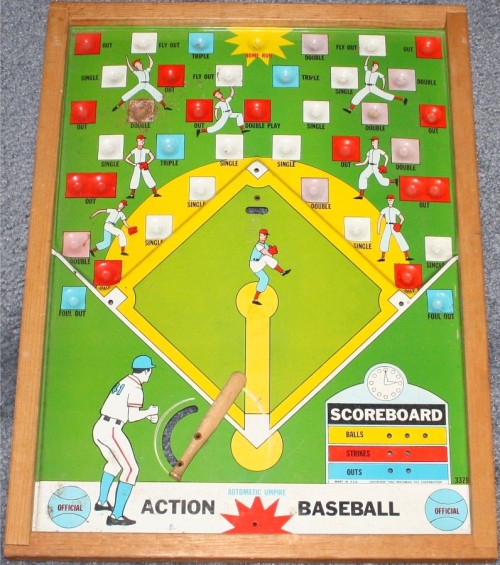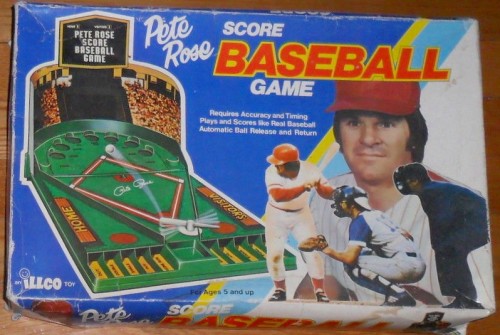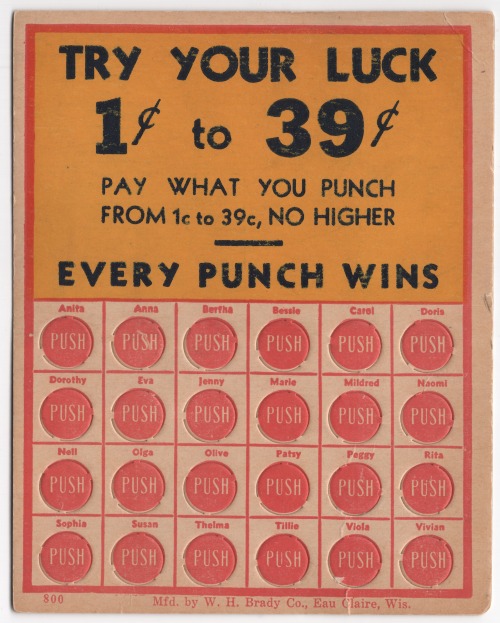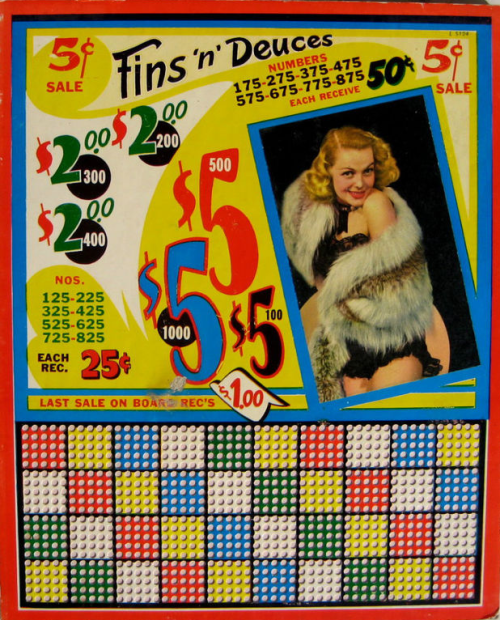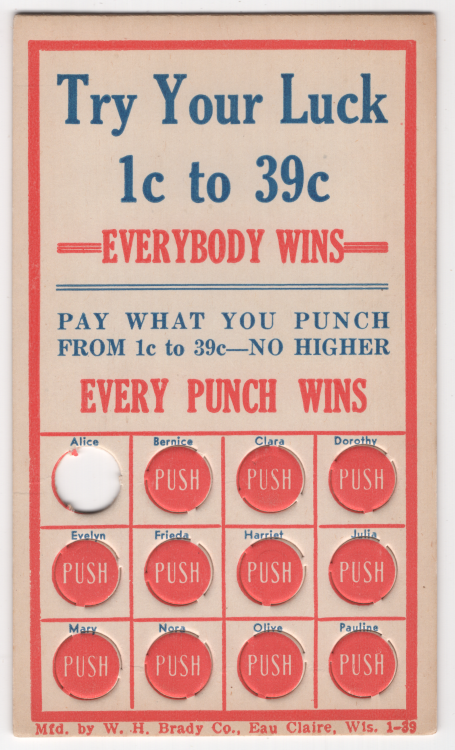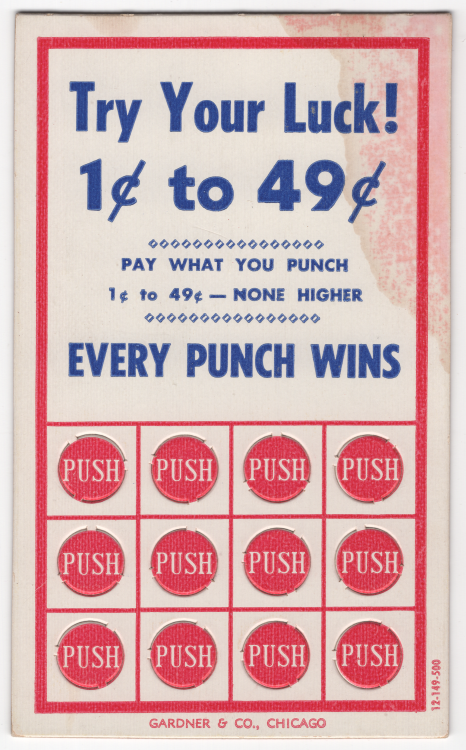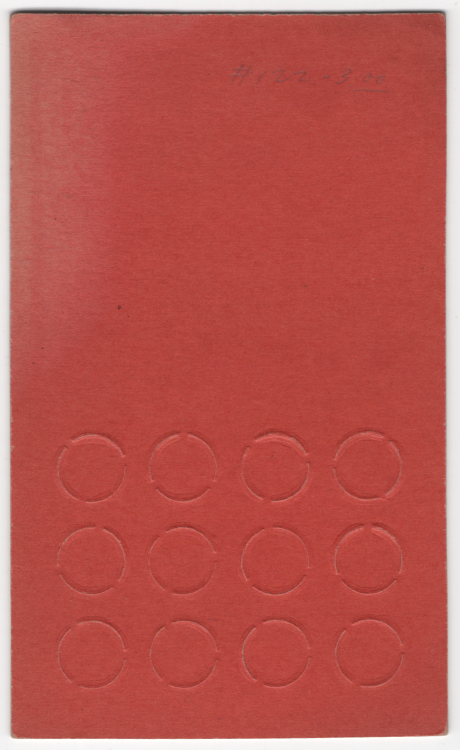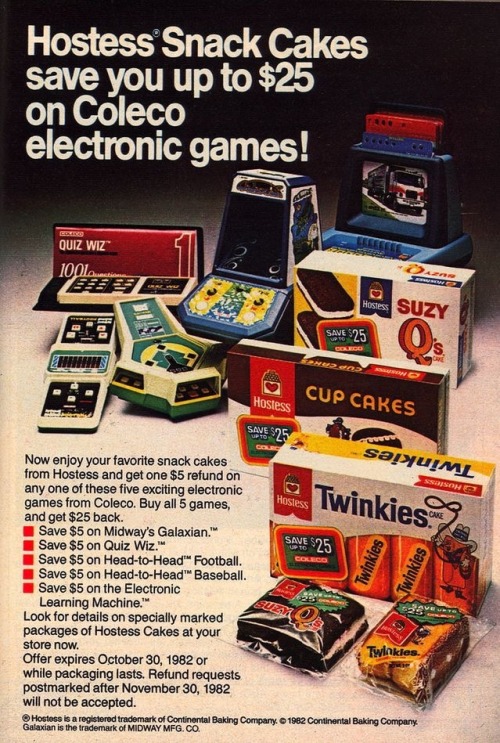#vintage games
Playing Metal Gear Solid 3: Snake Eater, and I’m loving it! The Revolver Ocelot part just makes me want to draw everyone as cowboys or something…
Post link
Punchcards
Before scratch cards, there were punchboards and punchcards.
While present in the USA from as early as the 18th-century, these lottery-style games found a peak in popularity in the early 20th-century. They were a form of gambling that could be found on every corner, in bars, barber-shops, drug stores, and retailers. They were played for cash or from physical prizes, and a play could cost as little as a penny.
How the game worked
The establishment owner (bars, drug stores, and other retailers) would purchase these games from a supplier (in a range of themes and designs), and sell customers the chance to select and punch a slot to reveal a prize or no prize the same way one might with a scratch ticket. Single plays could range from 1c-25c on average, depending on the prize, and some had more rules or chances to win.
Prizes
While cash prizes were the most obvious outcome of these games, some would offer trade prizes as well. On one hand, some would offer items as prizes, including cigarettes, booze, and candy (assumedly aimed at children) in place of cash. On the other, these games could be employed as a means of product/brand advertising, with prized related to products. One of the most prolific of these was done by Zippo, who between 1934 and 1940 sold more than 300,000 lighters through their promotional boards.
Themes
While these games could be purchased plain to be customised by the proprietor, others would be acquired with pre-printed themes and themed rules. Common themes were sports and entertainment, patriotism (especially during WWII), and pin-ups.
Types
Over time the forms of these games changed, but during the early 20th-century, two forms were most prominent — Punchboards and Punchcards.
- Punchboards
This is the older form of the game. These boards are comprised of two wooden boards or sheets of card with drilled holes, sandwiched between which is a sheet of paper or foil. Players would use a metal punch key tool to pierce their selected slot, revealing a folded slip of paper with their prize on it. These could accommodate thousands of slots/plays.
A variance on this model is the entertainment punchboards that could be purchased by individuals and which did not have prizes but were games to play at parties. They could reveal ‘fortunes’ or conversational ice breakers. - Punchcards
With developments in production technology, this is the thinner, younger brother of the punchboard. In place of the foil or paper, this style was comprised of two sheets of card glued together and with perforations that allowed the player to push out the desired slots with a finder rather than the metal key tool. The slots are significantly larger than the punchboard slots, with less plays per card. The trade-off for the smaller play options, is that they were much cheaper and easier to make, with many more suppliers producing them by the 1930s. - Pull-Tabs
These are much less common and there is very limited information on them. Rather than punching out a slot, the player would select and pull off slips of paper with the prize on it, or the player and proprietor would both pull cards and compare them to identify a winner.
If you want more in the topic, my full research notes on all topics are available for all $3+ Patreonpatrons!
Image Sources
Punchcard, “Try your luck,” Orange | SRNY Personal Collection.
Punchboard, “Charley Board” | Source
Punchboard, “Fins ‘n’ Deuces” | Source
Punchcard, “Try your luck,” White/Red - Used | SRNY Personal Collection.
Punchcard reverse, white - Used | SRNY Personal Collection.
Punchcard, “Try your luck,” White/Red | SRNY Personal Collection.
Punchcard reverse, white | SRNY Personal Collection.
Punchboard, “Cats Meow” Party version |Source
Punchcard reverse, red | SRNY Personal Collection.

This post series is thanks to my fantastic Patreon supports at the Ephemera Club level. For October 2021, the curated perks will be built around these punchcards, with ONE punchcard, and ONE accompanying fortunetelling arcade card!

If you would like to receive these and other cool items like them each month, head over to the Patreon. Spaces are limited! As I sadly only have punchcards for the currently subscribers, new patrons of this perk tier will instead receive a mystery item from a past month in its place.

[Support SRNY through PatreonandKo-Fi]
And join us onDiscordfor fun conversation!
I also have an Etsywith up-cycled nerdy crafts
Post link






